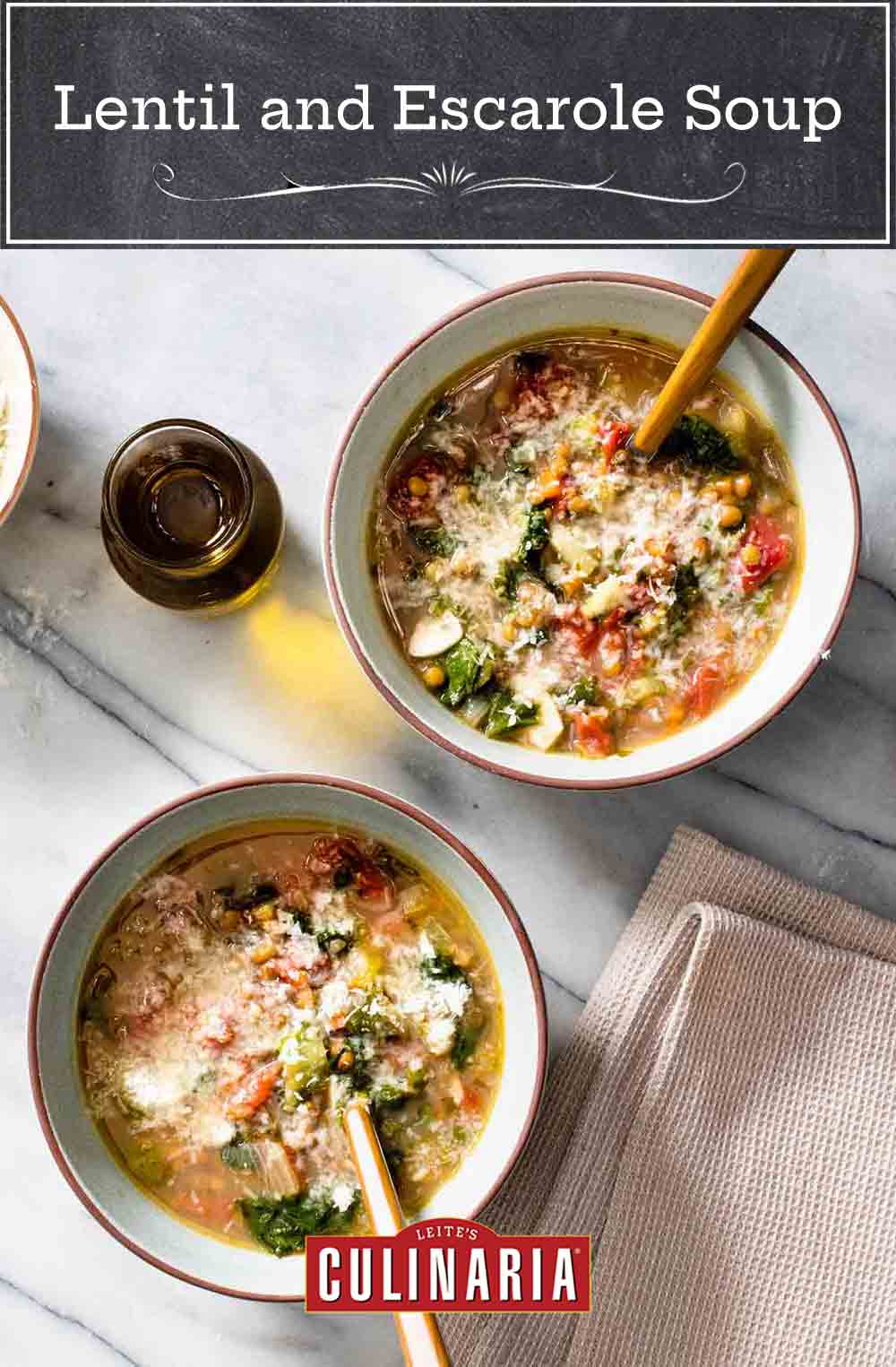
In the words of one of our recipe testers, this lentil and escarole soup is “truly the epitome of classic rustic Italian cooking.” We don’t disagree. Loaded with lentils and vegetables and finished with plenty of Parmigiano-Reggiano, it’s incredibly soul satisfying despite being tossed together with ease from inexpensive pantry staples. It also just happens to be vegetarian and gluten-free. In true Italian fashion, here’s to the simple things in life that taste anything but simple.–Angie Zoobkoff
*NOTE What Are Umbrian Lentils?
Tiny, deep green, and fragrant, lentils from the high, dry plains of Castelluccio in Umbria are considered some of the world’s best. They’re packed with minerals and are especially tender. However, these superior lentils aren’t abundant—a factor that contributes to their prized status. They’re commonplace in soup, a favorite wintertime primo. Because Umbrian lentils hold their shape particularly well during cooking, the soup remains brothy rather than thick and creamy.

Lentil and Escarole Soup
Ingredients
- 1 1/4 cup extra-virgin olive oil, plus more for drizzling
- 1 large onion, finely chopped
- 1 carrot, peeled and finely chopped
- 1 celery rib, finely chopped
- Sea salt and freshly ground black pepper
- 6 garlic cloves, thinly sliced
- 2 tablespoons minced fresh parsley
- 4 cups canned chicken broth or homemade chicken stock, plus more as needed
- 3 cups cold water
- 8 ounces Umbrian lentils* (see NOTE above) or brown lentils (1 1/4 cups), picked over and rinsed
- One (14 1/2-ounce) can diced tomatoes, undrained
- 1 Parmigiano-Reggiano cheese rind (optional), plus grated Parmigiano-Reggiano for serving
- 2 bay leaves
- 1/2 head escarole, trimmed and cut into 1/2-inch (12-mm) pieces (or substitute spinach, Swiss chard, Lacinato kale, or Belgian endive)
Instructions
- In a Dutch oven or large pot over medium heat, warm the oil until shimmering. Add the onion, carrot, celery, and 1/2 teaspoon salt and cook until the vegetables are softened and lightly browned, 10 to 15 minutes. [Editor’s Note: Yes, that's a lot of oil for not a lot of vegetables. We're asking you to take a leap of faith here. The generous amount of oil lends the finished soup an unmistakable richness that we suspect you’ll appreciate.]
- Stir in the garlic and parsley and cook until fragrant, about 30 seconds. Stir in the broth or stock, water, lentils, tomatoes and their juice, Parmigiano rind, if using, and bay leaves and bring to simmer. Reduce the heat to medium-low and cover, leaving the lid slightly ajar. Simmer until the lentils are tender, 25 to 30 minutes if using brown lentils and about 1 hour if using Umbrian lentils.
- Remove and discard the Parmigiano rind, if using, as well as the bay leaves. Stir in the escarole, a handful at a time, and cook until wilted, about 5 minutes or so. If you prefer a brothier consistency to your soup, add more hot broth as desired. Season with salt and pepper to taste.
- Ladle the soup into bowls and drizzle with extra oil, if desired. Pass the grated Parmigiano-Reggiano on the side.
Nutrition
Nutrition information is automatically calculated, so should only be used as an approximation.
Recipe Testers’ Reviews
This soup is unbelievably fantastic!!! It gets a solid 10 from us!!! The lentils melt in your mouth and the wonderful flavors and aromas of this soup seem like something straight out of Italy.
The secret has to be the amount of olive oil required for this recipe. It could also be the homemade chicken stock or the Parmesan rind or just the magical combination of all these ingredients together.
I couldn’t find escarole in my grocery store, so I used Belgium endive instead. I was stunned at the amount of olive oil used to cook the vegetables. I thought for sure this was a mistake and that there was no way this soup would be edible with this surplus of oil. After all the ingredients were added, there was an oil slick on top of the soup. I simmered it for an hour and 10 minutes, until the lentils were nice and creamy, and there was, surprisingly, no trace of oil at all.
The soup was a bit thick, so I added 1/2 cup additional chicken stock to loosen it up.
We were blown away with the first bite and have been enjoying this soup for 3 days now for lunch and I’m still licking the bowl clean!
This soup was spot-on in multiple ways—easy, delicious, healthy. Just the sight of a large pot of it simmering will put you at ease on a chilly evening. It was generously garlicky and the still-crunchy texture of succulent escarole was wonderful. It reminded me of wilted romaine lettuce in Stir Fried Lettuce and Lettuce Salad with Hot Beef Dressing, both of which I have become a sucker for.
The amount of olive oil seemed like a lot, but I think it gave the soup’s consistency some substance in a good way. Umbrian lentils weren’t available but I found their Spanish cousin, Pardina lentils, at the store. They’re also smaller than regular brown lentils and they keep their shape during cooking and they worked well with this recipe.
Healthful and delicioso, this Italian lentil soup gets its depth of flavor from quality olive oil, Parmesan cheese, and rich chicken stock. Although I was unable to find the Umbrian lentils, I used brown lentils, which were a quick-cooking substitute.
At first, the initial use of 1 1/4 cups olive oil to cook the veggies and aromatics seemed like a lot, but the richness of the oil carries through and makes for a rich soup base. I had some homemade chicken stock in my freezer which I used here and that made all the difference! Yes to the Parmesan rind.
I know it’s a traditional Italian cooking method to use water in most recipes, but I think if you have a nice stock on hand, it can easily be subbed in for the water.) The escarole is truly the perfect pairing for this soup; it wilts very nicely and almost just melts into the warm soup.
Depending on the saltiness of your homemade stock, it is very important to taste for salt and pepper at the end; I ended up adding about 1 teaspoon more to my batch of soup. May I suggest a sprinkling of crushed red pepper flakes to the finished bowls of soup, in addition to a touch more quality olive oil and some grated Parmesan cheese? The added cheese and oil at the end really gilds the lily, making for an added richness in each bite. This soup truly is the epitome of classic rustic Italian cooking at its best!
I served my soup with a side of haricots verts studded with crispy prosciutto and briny olives as well as toasted slices of roasted garlic bread.
I’m always looking for a good lentil soup recipe. It also happened that I came down with a cold so this was the perfect thing to help nurse me back to life.
For really simple ingredients, I was surprised by the amount of flavor in the final product, especially given that I ate it right after I cooked. (I often find soups need that day in the refrigerator to really sing.) I did use a small rind of Parmesan for more flavor and it did seem to really enhance the soup. I also coarsely grated more Parmesan and I loved the gooey clumps in the soup from it melting.
I went with 1/2 cup oil to cook the vegetables, which was ample. After I added the escarole, I went ahead and heated up another 1 1/2 cups chicken stock and added that to the soup. Eating this alongside a toasted baguette was very satisfying.

















Made this today with black lentils since that’s what I had on hand and wow. I’ve eaten a lot of different lentil soups and this one was honestly incredible.
Thank you so much, Christine. We’re delighted that you enjoyed it. Thanks for taking the time to comment.
I saw escarole in my local grocery store today and having never tried it, decided to take a chance on it today. Found your recipe and…a few hours later we happily are sated by this delicious soup!
Great, Steve!
This Alaskan has never seen or tasted escarole! Lament! Maybe in the big city, but never where I have lived here. Watercress falls in with escarole, too! Maybe this is an excuse to grow some? Does watercress grow in water? Really. I don’t know! Aiya!
Andi, you’re in luck! Watercress can grow hydroponically! As for escarole, I lived a few decades before I encountered it in Manhattan grocery stores. Luckily there are several ingredients you can use in its place. Kale likes cool weather, yes? Do you grow that in your garden?